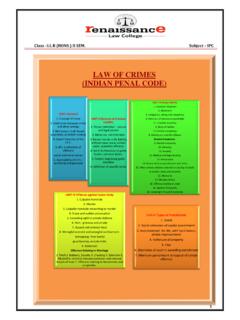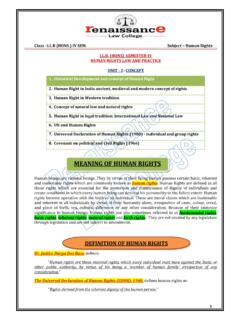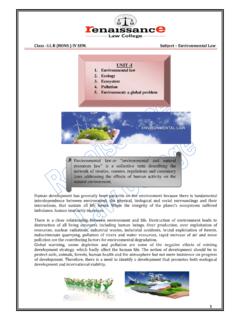Transcription of LAW OF TORTS INCLUDING MOTOR VEHICLE ACCIDENT AND …
1 Class (HONS.) I SEM. Subject Law of TORTS LAW OF TORTS . INCLUDING MOTOR . VEHICLE . ACCIDENT AND. CONSUMER PROTECTION. Unit-I Evolution of Law of TORTS 1 Forms of action, specific Unit-IILAWS. Justification in remedies from case to case tort 2 India - principles of justice equity 1. Volenti non fit injuria and good conscience-unmodified 2. Necessity, private and character- advantages and public disadvantages 3. Plaintiffs default Definition, Nature, Scope and 4. Act of God Objects of tort 5. Inevitable ACCIDENT Unit-III Doctrine of sovereign 1. A wrongful act- violation of duty 6. Private defense immunity and its relevance in India imposed by law, duty which is owed 7. Statutory authority 1. Vicarious Liability to people generally (in rem) - 8.
2 Judicial and quasi- 2. TORTS against persons and personal damnum sine injuria and injuria sine judicial acts relations damnumdoctrine 9. Parental and quasi- 3. Defamation and applicability. parental authority 2. tort distinguished from crime and 4. Parental relations, master and 10. Extinguishment of servant relation breach of contract and trusts. liability in certain 3. The contract of unliquidated 5. Malicious prosecution, wrongful situations. confinement damages 4. Changing scope of law of TORTS : 6. Wrongs affecting property expanding character of duties owed to 7. Trespass to land people generally due to complexities 8. Constitutional TORTS and Public of modern society liability for victim's compensation.
3 5. Objects-prescribing standards of human conduct, redressal of wrongs by payment of compensation, proscribing unlawful conduct by Unit-V Consumer Protection Act injunction. 1. Concept and definition of Consumer and service 2. Unfair trade practices Unit-IV Negligence 3. Supply of essential commodities and services 1. Basic concepts 4. Enforcement of consumer rights 2 Theories of negligence MOTOR VEHICLE Act 3. Contributory negligence 1. Types of ACCIDENT , At road intersections, 4. Special situations of negligence collision, involving children, excessive speed, in Lazardous Substance and floods, pedestrian, Running over cyclist and Hit Machinery and run case. product liability, liability towards 2.
4 Compensation and Right to Just ultimate transferee. Compensation. Nuisance 3. Claims and Claim Tribunal Composition, 1. Definition essentials and types Powers, Procedure and appeal against its orders. 2 Acts of obstructions (view and 4. Liability Insurance company, Third Party, formation of quees) Vicarious Liability Fault and no Fault liability, 3. Absolute and Strict liability Right to fixed compensation. 4. Legal remedies 5. Award of damages 1. Class (HONS.) I SEM. Subject Law of TORTS Unit-I Evolution of Law of TORTS 1 Forms of action, specific remedies from case to case 2 India - principles of justice equity and good conscience-unmodified character- advantages and disadvantages Definition, Nature, Scope and Objects of tort 1.
5 A wrongful act- violation of duty imposed by law, duty which is owed to people generally (in rem) - damnum sine injuria and injuria sine damnum doctrine and applicability. 2. tort distinguished from crime and breach of contract and trusts. 3. The contract of unliquidated damages 4. Changing scope of law of TORTS : expanding character of duties owed to people generally due to complexities of modern society 5. Objects-prescribing standards of human conduct, redressal of wrongs by payment of compensation, proscribing unlawful conduct by injunction. TORTS English perspective English tort law concerns civil wrongs, as distinguished from criminal wrongs, in the law of England and Wales. Some wrongs are the concern of the state, and so the police can enforce the law on the wrongdoers in court in a criminal case.
6 A tort is not enforced by the police, and it is a civil action taken by one citizen against another, and tried in a court in front of a judge (only rarely, in certain cases of defamation, with a jury). tort derives from middle English for "injury", from Anglo-French, from Medieval Latin tortum, from Latin, neuter of tortus "twisted", from past participle of torqu re. Following Roman law, the English system has long been based on a closed system ] of nominate TORTS , such as trespass, battery and conversion. This is in contrast to continental legal systems, which have since adopted more open systems of tortious liability. There are various categories of tort , which lead back to the system of separate causes of action.
7 The tort of negligence is however increasing in importance over other types of tort , providing a wide scope of protection, especially sinceDonoghue v Stevenson. For liability under negligence a duty of care must be established owed to a group of persons to which the victim belongs, a nebulous concept into which many other categories are being pulled. TORTS Indian perspective tort law in India is a relatively new common law development supplemented by codifying statutes INCLUDING statutes governing damages. While India generally follows the UK approach, there are certain differences which may indicate judicial activism, hence creating controversy. tort is breach of some duty independent of contract which has caused damage to the plaintiff giving rise to civil cause of action and for which remedy is available.
8 If there is no remedy it cannot be called a tort because the essence of tort is to give remedy to the person who has suffered injury. 2. Class (HONS.) I SEM. Subject Law of TORTS tort law in India, like her common law counterparts, stems from both statute and common law. Statutes Similar to other common law countries, aspects of tort law have been codified. Furthermore, the Indian Penal Code criminalises certain areas of tort law. Common law As tort law is a relatively young area of law in India, apart from referring to local judicial precedents, courts have readily referred to case law from other common law jurisdictions, such as UK, Australia, and Canada. Relevant local customs and practices However, attention is given to local socio-cultural practices and conditions in applying foreign legal principles.
9 The legislature have also created statutes to provide for certain social conditions; for example, due to the nature of Indian families, a statute was passed to simplify determination of damages in the event of family members Meaning of tort tort is a Civil / Legal Wrong. tort Law is one of the important branches of Civil Law. The word tort is derived from a Latin word 'Tortus' which means 'twisted' or 'cooked act'. In English it means, 'wrong'. The Expression ' tort ' is of French Origin. The term ' tort ' means a wrongful act committed by a person, causing injury or damage to another, thereby the injured institutes (files) an action in Civil Court for a remedy viz., unliquidated damages or injunction or restitution of property or other available relief.
10 Unliquidated damages mean the amount of damages to be fixed or determined by the Court. The 'Law of TORTS ' owes its origin to the Common Law of England. It is well developed in the UK, USA and other advanced Countries. In India, Law of TORTS is non codified, like other branches of law eg: Indian Contract Act, 1872 and Indian Penal Code, 1860. It is still in the process of development. A tort can take place either by commission of an act or by omission of an act. Wrong Public wrong - crime is a Public Wrong. These are acts that are tried in Criminal Courts and are punishable under the Penal Law (such as the Indian Penal Code, 1860 in India). Private wrong - tort is a Private Wrong. These are acts against an individual person or a person within a community and are tried in Civil Courts.










